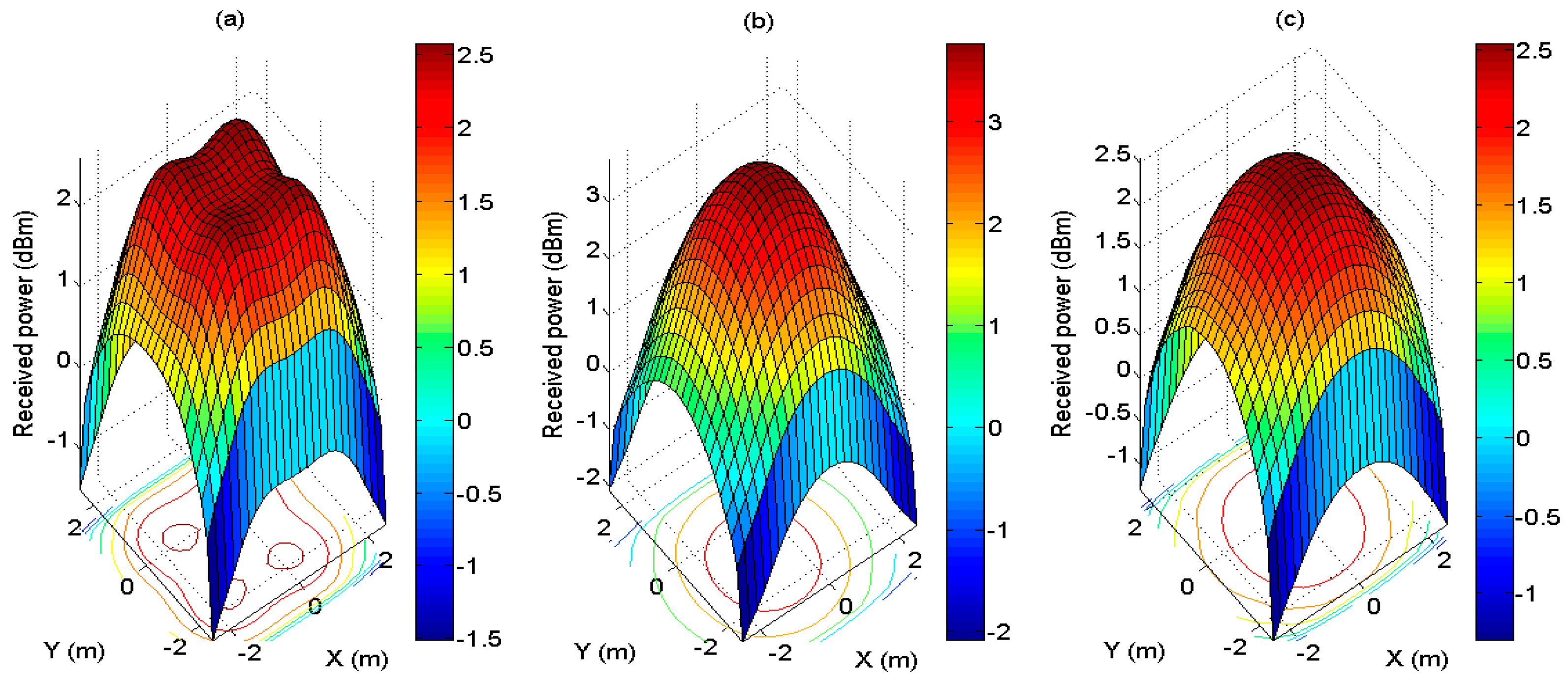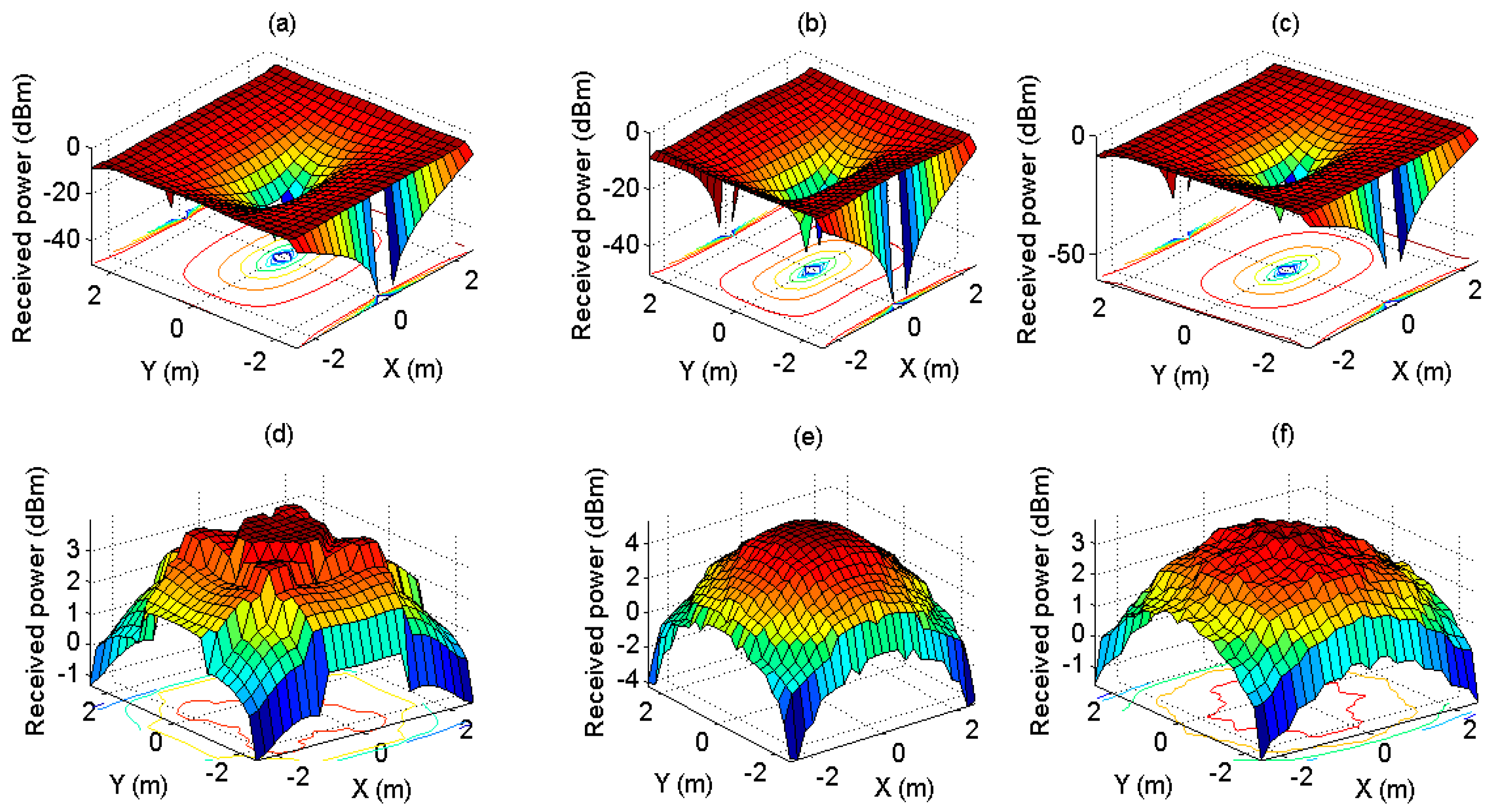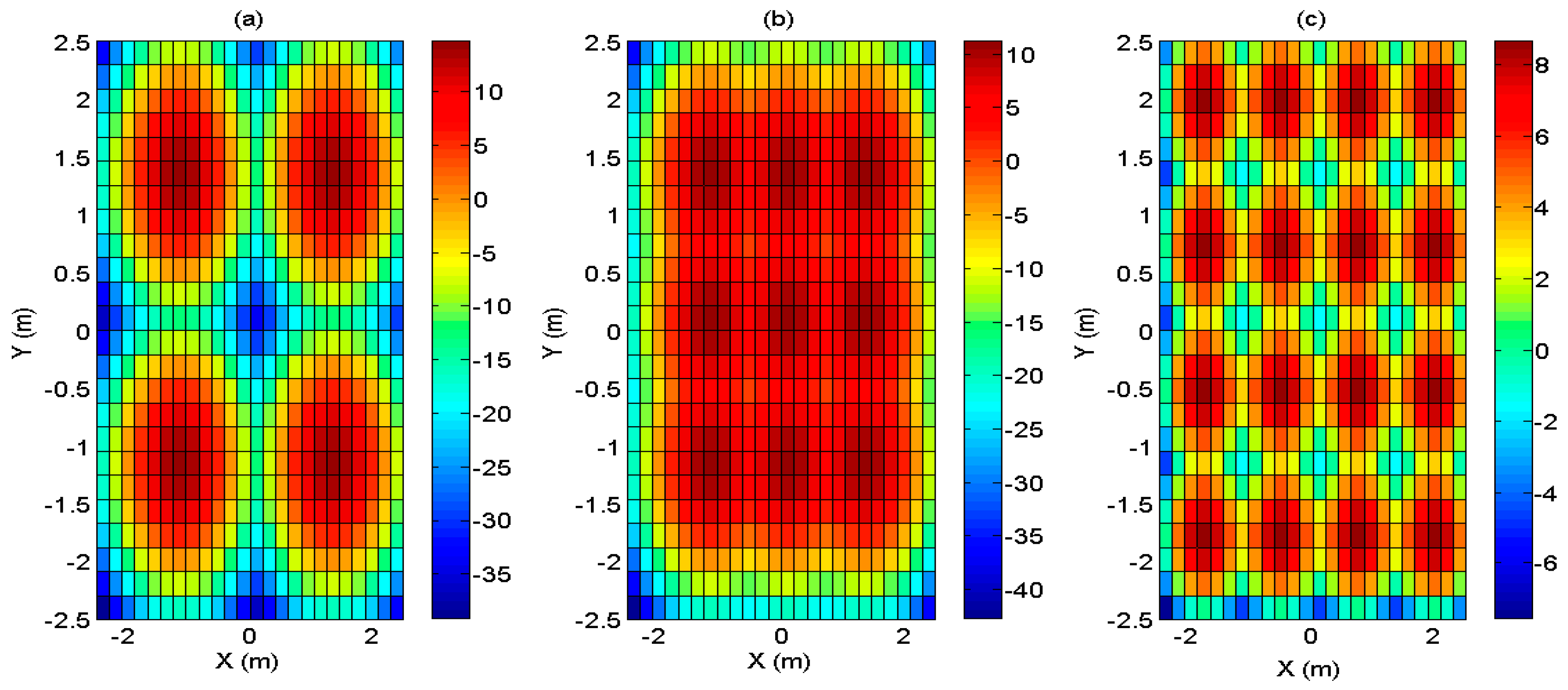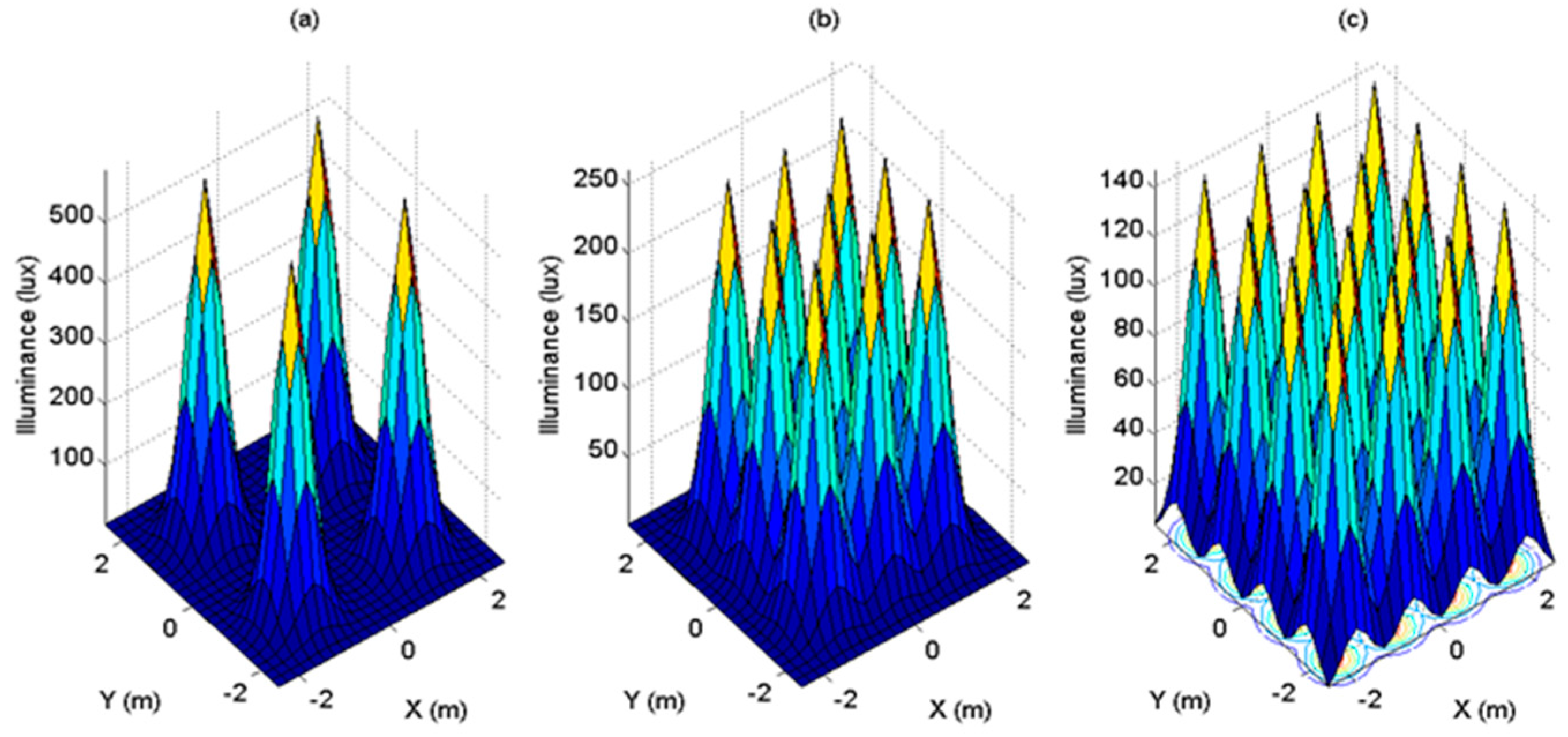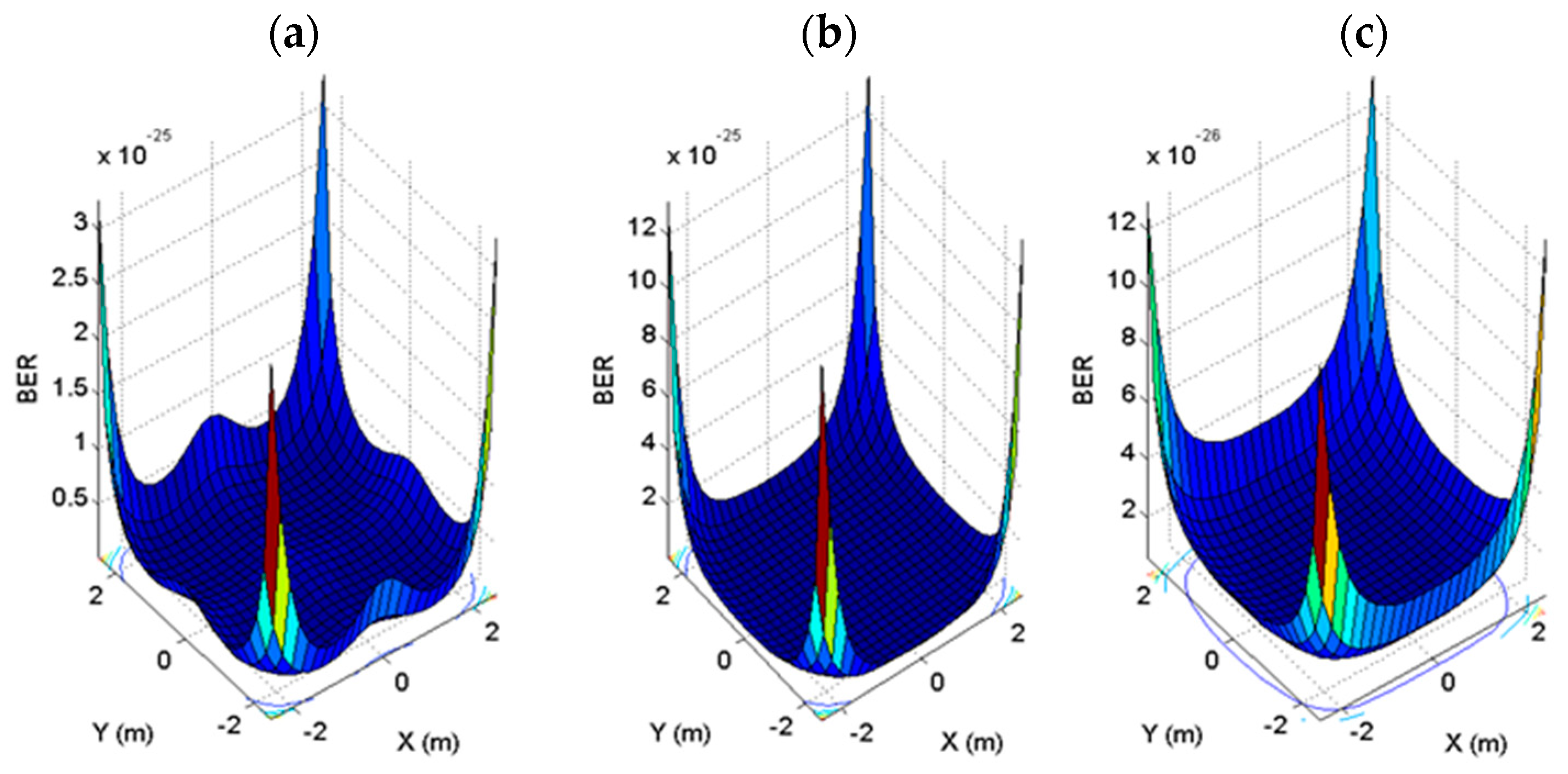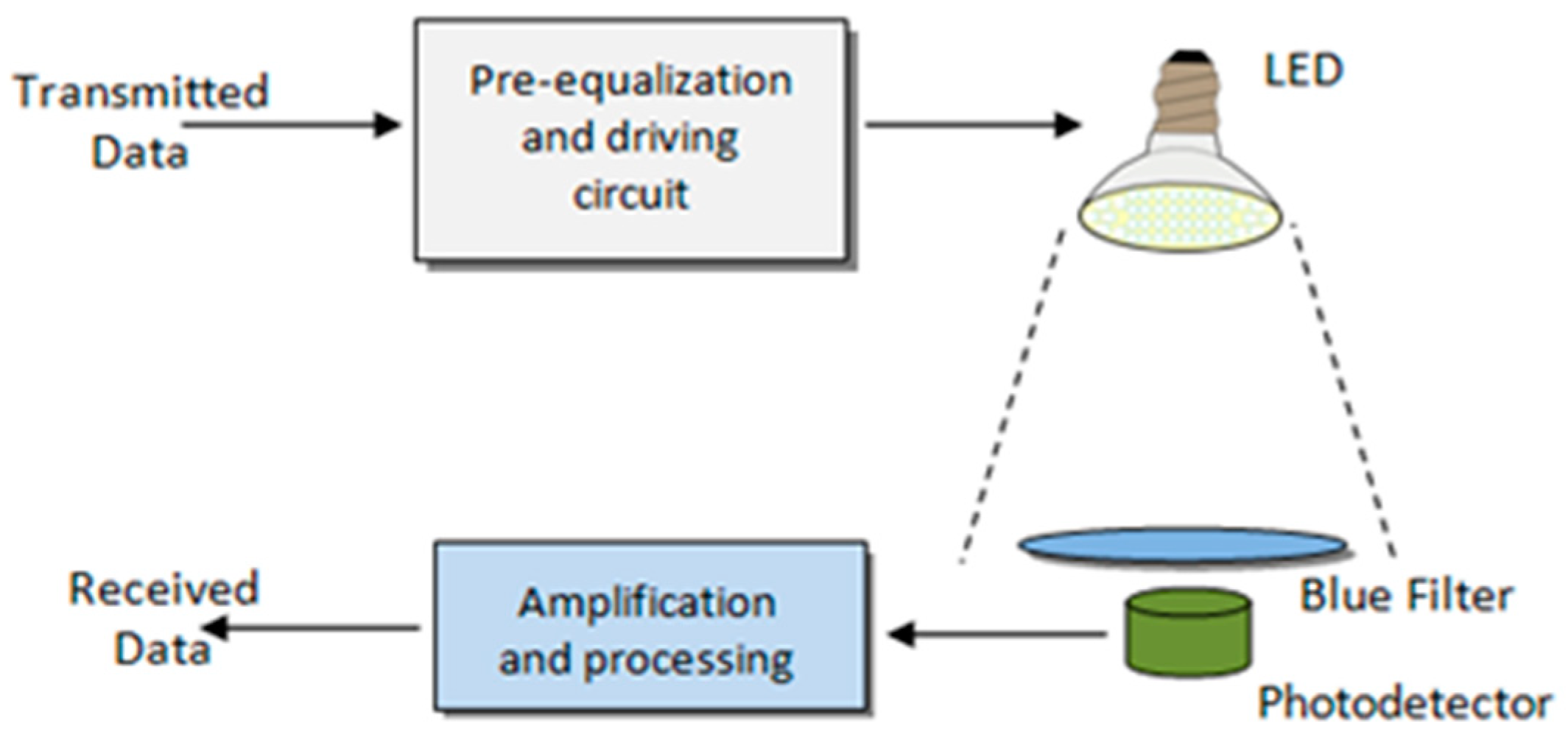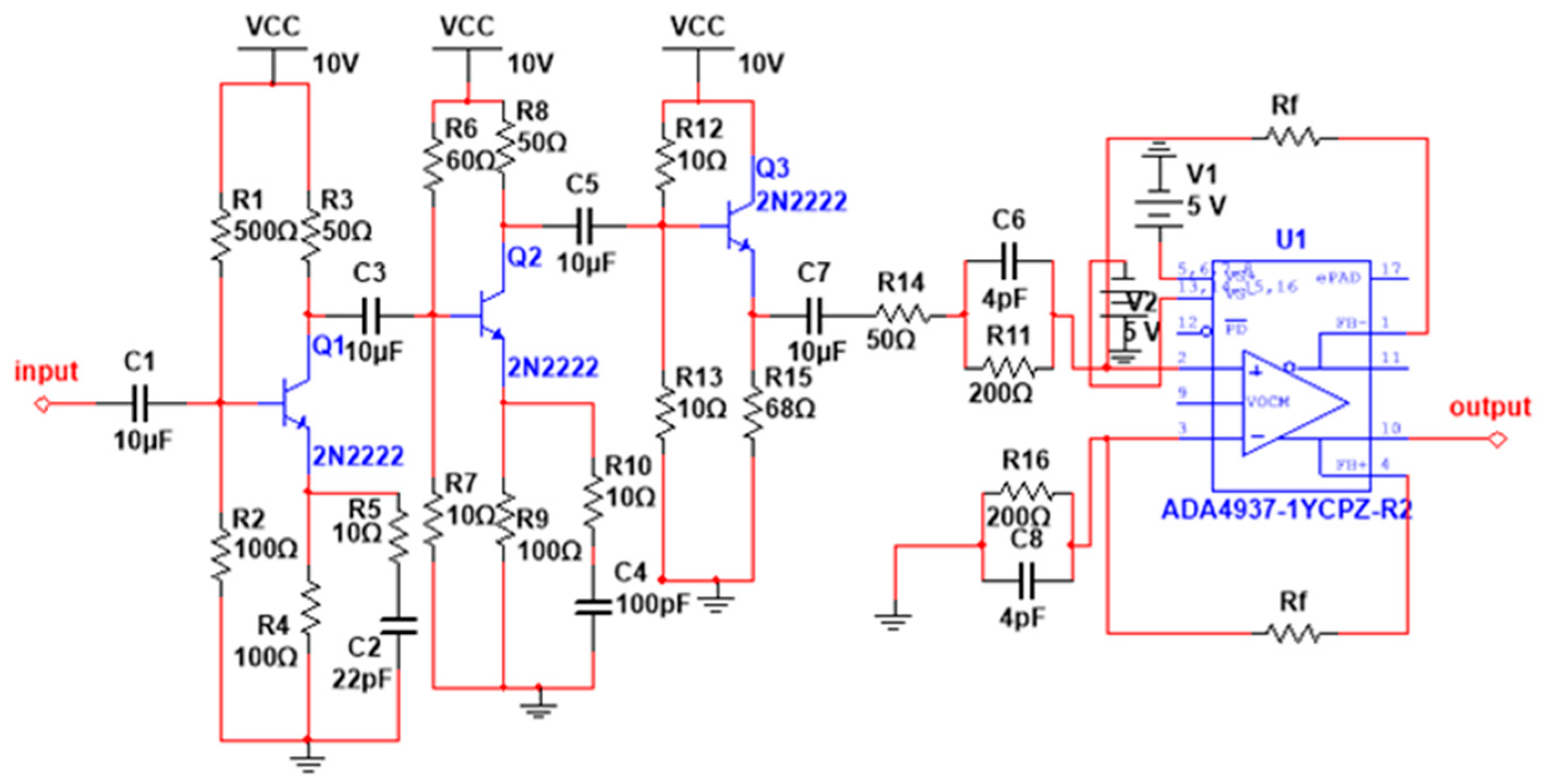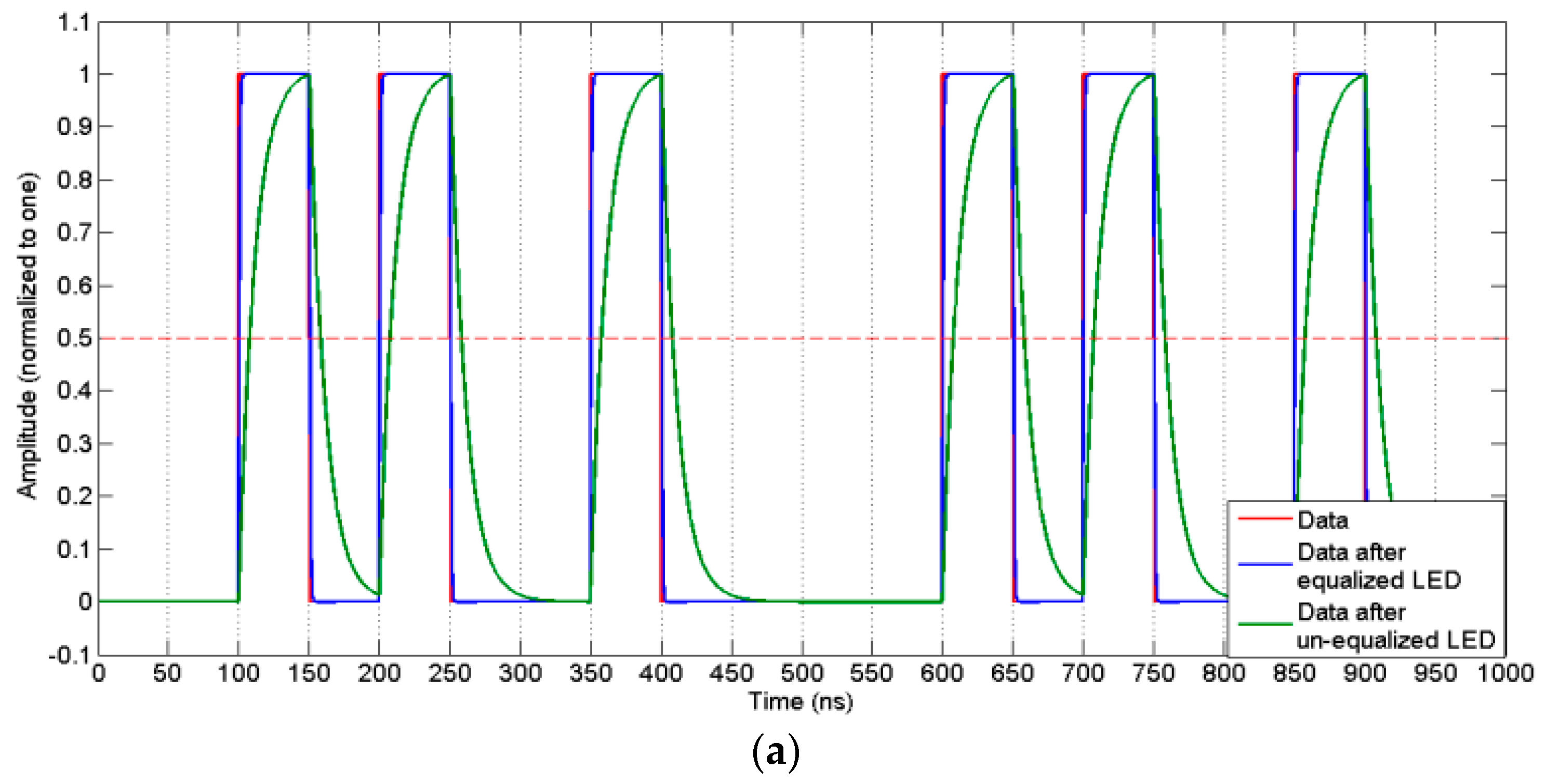1. Introduction
The limitation of the radio frequency (RF) spectrum can now be overcome by optical wireless communication (OWC) [
1]. Specifically, in indoor environments, OWC provides wide unlicensed bandwidths that enable wireless home networking systems to offload their data traffic as an alternative to existing RF systems. In addition, OWC is immune to interference from electromagnetic sources and are secure by design, as light cannot penetrate walls. The availability of light emitting diodes (LEDs) with high luminance resulted in inexpensive and efficient illumination devices [
2]. These devices will soon replace the existing fluorescent lamps and light bulbs, paving the way for a new technology known as Light Fidelity (Li-Fi) that utilizes visible light communications (VLC). In VLC, LEDs have a dual functionality of both illumination and data transmission by modulating light intensity at a rate that cannot be detected by human eyes. Due to its perception, VLC is considered secure, power efficient, and does not raise health concerns, making it a very promising technology for high-speed communications. However, commercially available LEDs have a limited modulation capability; hence, the transmission bandwidth of practical VLC systems is restricted.
In home and office environments, a typical indoor light fixture should provide illumination levels of about 200–1000 lux, depending on the performed tasks requirements [
3]. For general illumination, white colored LEDs are more desirable than single colored (i.e., red, green, yellow, blue, etc.). White light is either emitted by mixing red, green, and blue colored LEDs (i.e., RGB white LEDs) or combining phosphor with a blue LED (i.e., phosphor white LEDs). Phosphor white LEDs are more commonly used because they are easier to implement at lower costs. However, the phosphor coating limits its switching speed to only few MHz. The phosphor-based LED typically consists of a blue LED chip covered by a yellow phosphor layer. However, when this phosphor-based LED is used for the VLC, the modulation bandwidth is limited by the long relaxation time of the phosphor, limiting the transmission capacity of the VLC. White LEDs are usually blue InGaN LEDs with a coating of a suitable material. Cerium(III)-doped YAG (YAG:Ce
3+, or Y
3Al
5O
12:Ce
3+) is often used with a decay constant in the range of tens of nanoseconds [
4]. Techniques such as blue-filtering [
5] as well as pre-equalization [
6,
7] and post-equalization [
8] are different techniques reported in the literature to extend both bandwidths and data rates. In Reference [
5], even though blue-filtering achieved a significant bit-error-rate (BER) enhancement, the communication distance was limited to just 30 cm. Post-equalization techniques, as in Reference [
8], are performed at the receiver’s end, which results in noise magnification and limits the communication distance in the cm range. The most recent bandwidth extension by pre/post-equalization circuits was reported by Huang et al. [
9], yet the bandwidth was only extended to 304 MHz. Other researchers apply different modulation formats such as orthogonal frequency division multiplexing (OFDM) [
10,
11]. However, complex modulation techniques increase the system’s architecture complexity. On the other hand, in order to mitigate the limitations of LED-based multiple-input multiple-output (MIMO) VLC systems, previously conducted credible studies were scrutinized to understand their strengths and weaknesses [
12,
13,
14,
15].
The contributions of this paper can be divided into two parts. Initially, a new LED array pattern is proposed in an indoor VLC system in order to achieve a more uniform light (i.e., illumination) distribution. The impact of both the receiver and the transmitter angles on the transmission performance of the proposed model is studied and the output is compared with other related distribution patterns in the literature maintaining the same number of LEDs used. Additionally, the SNR and BER performances of the proposed systems are measured to compare the system performances for all investigated distribution LED patterns. The paper also studies the impact of increasing the number of arrays to further investigate the factors affecting system performance. Then, due to the bandwidth limitation of the blue phosphorus white LED used, this paper proposes a new designed pre-equalization circuit in order to overcome such limitations. The proposed analog pre-emphasis circuit is used to further extend the LED bandwidth with the aid of blue filtering to reach 416 MHz, which is the widest bandwidth reported in the literature to the best of the authors’ knowledge. In the following section, the simulated MISO VLC system model using MATLAB is first presented, and then, the impacts of the studied parameters of the different distribution patterns on the system performance are compared. In
Section 3, the equalization circuit is described, and the corresponding results are displayed and discussed in
Section 4.
Section 5 is devoted to the main findings of the paper.
2. MISO VLC System Model
The VLC system parameters that are used in References [
12,
13,
14,
15] are initially adopted (see
Table 1) in this paper to compare the system performances of the different LED arrangements. The transmitters consist of 2-D rectangular white LED [
16] arrays of low intensities. These array patterns are distributed as shown in
Figure 1 along the ceiling.
Phosphorescent white LEDs used in this paper are assumed to generate a Lambertian radiation pattern. At the receiving plane, the radiation intensity is given by Reference [
3].
where
is the irradiance angle with respect to the axis perpendicular to the transmitter surface.
I(0) is the center luminous intensity, and
is the Lambertian emission order which is defined by:
where
is the LED semi-angle at half illuminance.
On the other hand, the received power is given by Reference [
3]:
where the transmitted power is
Pt,
HLOS(
0) is the LOS link DC gain,
HnLOS(
0) is the non-LOS link DC gain, and
Hrefl(
0) represents the reflected path DC gain.
The DC gain for a LOS link receiver with a Lambertian source can be approximated as [
3]:
where
is the incident angle to the axis perpendicular to the receiver surface. The incident angle is given that
, where
φcon is the field-of-view (FOV) receiver angle. The receiver area is
Ar, while
Ts(φ) and
are the filter transmission coefficient and the concentrator gain, respectively. The distance between the LED source and the photodetector surface is
d.
The reflected path DC gain is given by [
14]:
where the distance between the LED source and a reflection point is
d1, the distance between a reflection point and the receiver surface is
d2, and
ρ is the reflectance coefficient. The reflective area of a small region is
dAwall,
α is the incident angle to a reflection point, and
β is the irradiance angle to the receiver.
The power radiated among the room from the three different array patterns is plotted in
Figure 2 by applying Equations (3)–(5). The total number of LEDs in all models is fixed.
The performance of the models is summarized in
Table 2, which shows the average, minimum, maximum, and standard deviation (STD) of the received power for each model. It is observed that the 9 arrays model has the highest average
Pr. However, it also has the highest deviation between the minimum and maximum
Pr. This deviation causes signal fluctuations among the room, leading to a largely varying SNR and link unreliability. On the other hand, the performance of the 4 arrays and 16 arrays models is close under the given parameters.
Since the performance of any communication system is limited by its SNR, the received power of the link has to be increased. According to Equations (3)–(5), the received power, Pr, depends on many factors, including the receiver’s FOV and the transmitter’s (LED) half power angle, . It can be observed that Pr is inversely proportional with the receiver’s FOV and the transmitter’s . So, in order to increase Pr, the values of these two parameters should be decreased.
To analyze the effect of reducing the receiver FOV, the simulations in the previous section are repeated. Instead of using FOV = 70°, a receiver FOV of 60° then 50° are used.
Table 3 shows the maximum received power in dBm for the first reflection paths and the total received power for the three cases under the three different values of the receivers FOV. The values of the maximum first reflected path received power do not vary greatly for each case; however, the power distribution pattern changes significantly, as shown in
Figure 3.
In
Figure 3, the FOV is fixed to 50°, and the first reflection path and the total received power are plotted for each case. It is clear that the area in the middle of the room starts receiving almost zero power from the first reflection path, and as the FOV gets smaller, the area gets larger. Moreover, the received power pattern becomes less uniform as the FOV gets smaller, causing the case of using 9 arrays and 16 arrays to have an advantage over the case of using 4 arrays. By increasing the number of transmitters in the room, the power becomes more evenly distributed. Hence, even if a receiver of narrow FOV is used, the power pattern will still maintain its uniformity. However, most practically used PIN photodiodes (receivers) such as those in References [
17,
18,
19] have FOV angles of about 65, thus this study is not extended for FOV angles less than 50°.
The transmitter half power angle (i.e., semi-angle at half luminance),
, is the angle from the axis perpendicular to the LED by which the luminous intensity is only 50%. This angle is the viewing angle (i.e., the half-intensity beam angle). Its value is about 10–12° with no diffusion, such as in Reference [
20], which is controlled by the reflector cup (that surrounds the LED chip) properties. However, this angle reaches up to 70° at maximum diffusion, as described in many scenarios [
13,
14,
15].
To analyze the effect of reducing the transmitter half power angle
, the simulations using the system parameters given in
Table 1 are repeated, firstly by considering the case of a non-diffused LED with
= 10° instead of
= 70°. The tremendous difference is clear in
Figure 4, where the received power pattern has changed greatly when compared to
Figure 3. The patterns have less uniformity and the location and number of transmitters are now visible in the surface plot. The received powers are recalculated in
Table 4 for
= 10°.
The received power,
Pr, increases significantly when compared to the case of
= 70°, and so does
Pr STD. The case of 16 arrays outperforms the other two configurations under the fixed system parameters defined, having the highest average
Pr and the least
Pr STD. Still, the system needs to be tested for practicality, as these LEDs are placed with the main purpose of illumination, the level of illuminance for the case of
= 10° has to be within the typical office illuminance requirements (i.e., 200 to 1000 lux) [
3].
Using Equation (2), the illuminance of the three transmitter configurations at
= 10° is plotted in
Figure 5. The plots show poor performance in all three cases.
Table 5 shows the maximum and average illuminance (lux) for each case. The average illuminance in all cases is not within the required range for illumination, which is due to the fact that, from Equation (1), the radiation intensity and illuminance depend heavily on the value of
ml, which is a function of
.
However, the presence of commercial LEDs with small
encouraged further investigation on utilizing the advantage of using LEDs with small half power angles. This increase in received power can be very useful in applications that require a high SNR. The proposed model performance is further evaluated by obtaining its BER, employing on-off keying with
= 30°. The BER and SNR are, respectively, given by [
3]:
where the Q-function is defined as
given
as the cumulative distribution function of the normal Gaussian distribution and
where the photodiode responsivity is represented by
R.
As presented in References [
21,
22,
23], the total noise variance
σ2T is
where
q is the charge of electron and
k is Boltzmann constant.
The BER parameters are shown below in
Table 6, and the BER for each transmitter configuration at
= 30° is presented in
Figure 6. It is observed that the BER in almost the entire room, excluding the corners, has a constant value.
According to the previous analysis, it is clear that the 16 arrays case has outperformed the two other cases, which encouraged the extension of this work to include 25 and 36 arrays. The analysis is repeated keeping a fixed number of LEDs for all array patterns and the same room parameters used in
Table 1, except for the transmitter half power angle
. The illuminance and received power investigations are repeated but this time employing an LED with
equal to 30°, like the one used in Reference [
14]. The obtained values are summarized in
Table 7, where the 16 arrays case has the lowest illuminance level and the least illuminance STD. All the transmitter configurations under the condition
= 30° have an average illuminance within the illumination requirements of a typical room, but with the 16 arrays configuration having the advantage of better pattern uniformity. The calculations to obtain
Pr are repeated for
= 30°, the values are given in
Table 8.
Moreover,
Table 9 includes the minimum BER values when the bit rate is varied to check the consistency of the conclusions attained. The variations between the five configurations at the same
are minimal, causing the 16 arrays to be the most efficient one even if configurations have slightly less BERs. Looking at
Table 9, the five transmitter configurations showed an improvement in the BER performance at
= 30°, for all data rates, over the case of
= 70°.
As depicted in
Table 7,
Table 8 and
Table 9, the 25 arrays case has a higher
Pr STD of 2.0, a slightly higher
Pr average, and less BER when compared to the 16 arrays case. The STD of the SNR in this case is equal to 4.0, as opposed to 2.3 in the case of the 16 arrays. On the other hand, the case of 36 arrays has a
Pr STD of 1.8, still higher than the case of the 16 arrays, resulting in a SNR STD of 3.7. It also has a slightly higher average
Pr when compared to the 16 arrays case, and less BER. However, these cases might not be practically preferred, as they will increase the complexity of the LEDs installation in the room.
To summarize the outputs of this section, the 16 arrays configuration has persistently shown a better pattern uniformity in comparison with the other rectangular transmitter arrangements at = 30°, having;
However, this comes at the expense of a slightly higher BER when compared to the other configurations. Hence, the 16 array configuration at = 30° is chosen, and the preceding section is dedicated to the equalization of the LED fixtures.
4. Simulation Results
Table 10 shows the maximum attained bandwidth versus the magnitude of the signal gain at the 3 dB frequency point. It is clear that the smaller the feedback resistance is, the wider the maximum bandwidth is achieved. The gain decreases down till 200 Ω, and then the performance of the system starts to deteriorate.
To understand why the performance of the system starts to deteriorate, the time response of the second stage of our circuit is studied. It is observed that below 200 Ω, the operational amplifier starts acting as an attenuator and not as an amplifier. The time response of the second stage of our circuit alone yields the gains depicted in
Table 11. So, even when the 180° phase reversal occurs in the frequency response of the entire circuit which occurs at 430 MHz, in the case when
Rf = 150 Ω, the 3 dB bandwidth is noticeably less due to the gain magnitude.
The
Tr and
Tf are 20 ns and 130 ns, respectively, and the total response time is about 150 ns, while the fall time, on the other hand, is longer because of the phosphor’s slow response. Data rates of 20 Mb/s, 200 Mb/s, and 2 Gb/s, are convolved with the responses of the both the unequalized and equalized LEDs, as depicted in
Figure 9a–c, respectively. At 20 Mb/s, the data can still be recovered without the need for equalization, as can be seen from
Figure 9a. The data after equalization is almost identical to the transmitted data. The limitations of the LED modulation bandwidth become apparent at higher speeds. At 200 Mb/s, the need for equalization is apparent. However, the response after equalization shows that the data can still be recovered with a low BER. On the other hand, at 2 Gb/s, the data almost seems unrecognizable without equalization, and even with equalization, the BER would still be very high. The bit error calculations caused by the LED limited bandwidth shown in
Figure 9 (taking 50 samples/bit duration) shows that at 20 Mbit/s both the unequalized and equalized LEDs have zero error. On the other hand, only the equalized LED has zero error at 200 Mbit/s, while at 2 Gbit/s, the error occurs in both cases but is significantly less with the equalized LED.
The BER is calculated with different numbers of random bits up to 200,000 in order to verify the consistency of the obtained results and the efficiency of the proposed circuit. At 20 Mbit/s, the BER was negligible using both the un-equalized and equalized systems. At a higher data rate of 200 Mbit/s, the equalized system was able to eliminate the un-equalized LED BER of 0.36. On the other hand, at 2 Gbit/s, the proposed equalized system reduced the 0.49 BER to 0.27 (i.e., 44.2% improvement). However, at high speeds (i.e., 2 Gbit/s), the BER for both cases is still very high and cannot be employed in a practical communication system. Future work will include addressing solutions for high data rate transmission.

